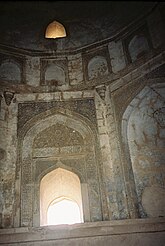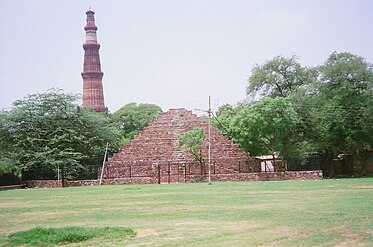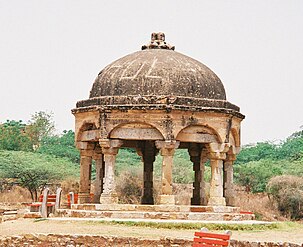Metcalfe House
| Metcalfe House | |
|---|---|
Dilkhusha | |
Qutb Complex (Mehrauli Archaeological Park) | |
| Coordinates | 28°31′21″N 77°11′13″E / 28.52244°N 77.18695°E |
| Current tenants | Archaeological Survey of India |
| Destroyed | 1857 |
| Client | Sir Thomas Metcalfe |
| Landlord | Government of India |
| Technical details | |
| Structural system | stones and brick |
| Design and construction | |
| Architect(s) | Sir Thomas Metcalfe |
Metcalfe House is the name given to two residential houses built in the 19th century in
The first house near the Civil Lines, called the 'town house', was built in 1835 in colonial style, near the present day Inter State Bus Terminal (ISBT). He resided there till his death in 1853. It was badly damaged during the
The second Metcalfe House, known as 'the retreat' or 'Dilkhusha', was also built by Sir Thomas Theophilus Metcalfe as a country house in
The town house

Metcalfe built his town house, close to the
The wide verandah, encircling the main building on all sides, was supported on impressive stone columns. Inventive underground rooms called the tykhanas were used for cool comforts during the summer season and for playing billiards. A library with 25,000 books and a
In this once happy home you all passed your earliest infancy. With exception to Emy and Charley all were born here- and all but Charley have received the initiatory right [sic] of baptism by which Ye were made member of Christ Children of God and inheritors by promise of the Kingdom of Heaven. To your father it has been endeared by many years of more…
An unusual tale recounted is of a lavish
The building is now the headquarters of the Defence Scientific Information & Documentation Centre (DESIDOC) in Delhi.([12]
The Retreat or Dilkhusha
The second house in Mehrauli was initially a tomb of Muhammad Quli Khan, brother of Adham Khan, a general and foster brother of Emperor Akbar. The octagonal Mughal tomb built in the 17th century was bought by Metcalfe and remodeled in the style of European residences with extensive gardens and follies for use as a pleasure resort during the monsoon season. He called it the 'Dilkhusha' (also see under External link of the album showing two pictures of Dilkusha as it existed when built). It was spread over a sprawling area, which is now enclosed in a specially developed park called the 'Qutub Archaeological Village'. The purpose in building this place was stated to be that Metcalfe wanted to keep a watch on Emperor Bahadur Shah II who also had his Zafar Mahal palace in Mehrauli to spend his summer time.[3][6][13][14]
The complex was a pleasant place with several controlled streamlets of water, which led to a tank (now called the Metcalfe's Boathouse and Dovecote). The tank was dated to the
All of the above can be seen in the Archaeological Park (a special enclosure created recently), which has strategically placed signages showing directions to the various heritage monuments. This village was created by the
The retreat had been built like a
The ruins of grandeur that extend for miles on every side fill it with serious reflection," he wrote. "The palaces crumbling into dust... the myriads of vast mausoleums, every one of which was intended to convey to futurity the deathless fame of its cold inhabitant, and all of which are now passed by, unknown and unnoticed. These things cannot be looked at with indifference.
Gallery
-
Dilkhusa with the tomb of Adham Khan, in the distance, 1843
-
Inside view on walls and roof of the central hall of the Dilkhusha in the former Quli Khan tomb
-
A Panoramic View ofQutub Minarfrom old Metcalfe house(Dilkhusha) with Guest House in the foreground on the left
-
Metcalfe's Guest House in ruins
-
Ruins of Sir Thomas Metcalfe's Guest House at Dilkusha.
-
Qutb complex
-
Another (Ziggurat) folly at entrance to Qutb Archaeological village, Mehrauli
References
- ^ a b c d "Grand designs in Delhi: Mughal tombs converted into palatial mansions, lighthouses built in city gardens and pavilions floating on water. William Dalrymple explores the eccentric architectural legacy of colonial Delhi". The Times of India. 22 October 2006. Retrieved 3 June 2009.
- ^ )
- ^ a b c d Y.D.Sharma (2001). Delhi and its Neighbourhood. New Delhi: Archaeological Survey of India. pp. 49, 60, and 141. Archived from the original on 31 August 2005. Retrieved 24 April 2009.
{{cite book}}:|work=ignored (help) - Legislative Assembly of Delhiwebsite.
- ^ Addresses[usurped]
- ^ a b c d Fiona Hedger-Gourlay; Lindy Ingham; Jo Newton; Emma Tabor; Jill Worrell (13 September 2006). "Lal Kot and Siri" (PDF). pp. 4–11. Retrieved 4 June 2009.
- ^ "Houses in Delhi in the 1840s". British Library: Help for Researchers. Archived from the original on 22 March 2009. Retrieved 4 June 2009.
- )
- ^ a b "This time, that age". The Hindu. 28 December 2003. Archived from the original on 31 January 2004. Retrieved 3 June 2009.
- ^ Sir Thomas Metcalfe. "Details at British Library page". British Library. Retrieved 3 June 2009.
- ISBN 81-900601-2-0. Page 220.
- ^ "The forgotten history of Metcalfe House". Delhipedia. Retrieved 30 May 2024.
- ^ Alfred Frederick Pollock Harcourt (1866). The New Guide to Delhi. G.A. Savielle. p. 132. Retrieved 1 June 2009.
Metcalfe House, Delhi.
{{cite book}}:|work=ignored (help) - ^ a b "The last Mughal chronicler". The Business Standard. 11 June 2006. Retrieved 3 June 2009.
- ^ "Inside Delhi of Kunwari Begum and Dadi-Poti..." The Hindu. 22 May 2002. Archived from the original on 23 October 2002. Retrieved 3 June 2009.
{{cite web}}: CS1 maint: unfit URL (link) - ^ "A case of Delhi poisoning?". The Hindu. 4 April 2004. Archived from the original on 6 November 2004. Retrieved 3 June 2009.
- ^ "Exploring the Mehrauli Archaeological Park". Retrieved 3 June 2009.








